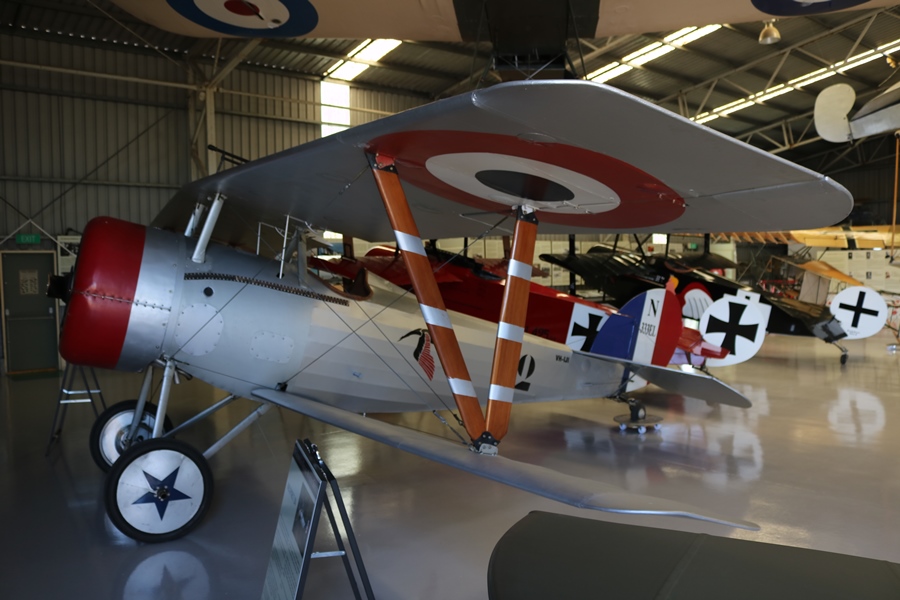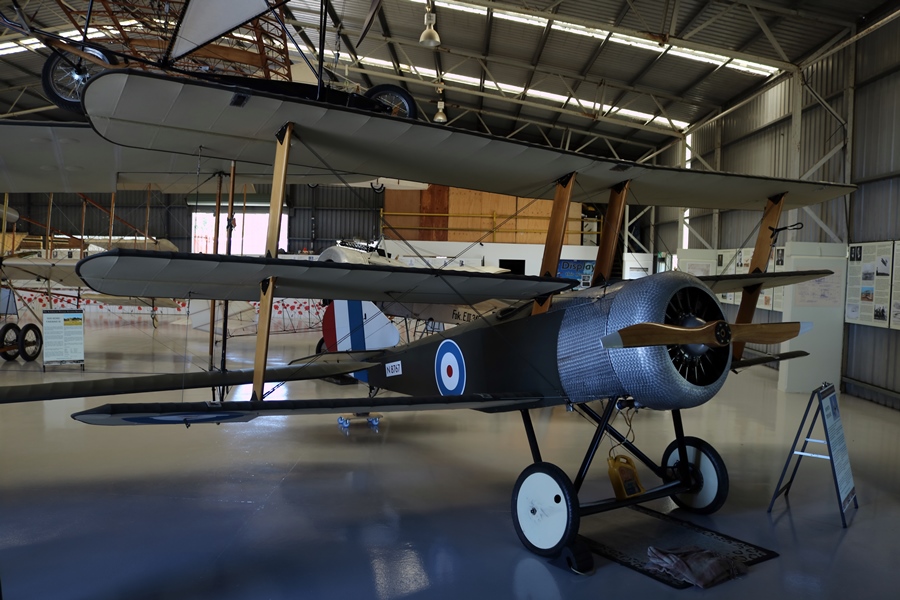Walk in, take in the view, smell the rotary engines lubricated with castor oil and take a step back in time… Welcome to The Australian Vintage Aviation Society (TAVAS) Museum!
TAVAS, a non-profit, volunteer based organisation is located in Hangar 106 at the Caboolture Aerodrome on the Sunshine Coast of Queensland has a fantastic collection of flying reproduction and replica World War One and early pioneering aircraft. The reproduction aircraft are built to the same specifications as the original and feature a reproduction engine that looks and works the same as those used in the Great War – some even have an original engine! The replica aircraft are generally built to the same specifications as the original but are fitted with a modern engine, modified to fit the engine cowling and look highly authentic (it works!).


Replica and reproduction aircraft in the collection include those built in Australia, South Africa, the United States and New Zealand (The Vintage Aviator Ltd.). Non flyable aircraft are suspended from the ceiling but pretty much any aircraft sitting on the floor could be flown just as the originals they represent once did and they do fly at air shows and events. Aircraft in the collection include:
Pioneers
The 1901 Whitehead No. 21 Condor replica is a strange, winged boat/bird like creature suspended from the TAVAS hangar ceiling! Apparently “Janes All the Worlds Aircraft” reports that the original of this ungainly looking aircraft, flown by its designer Gustave Whitehead in August 1901, was allegedly the first aircraft to gain heavier than air powered flight and not the Wright Brothers in 1903 (an apparently repeated again before the brothers in the No. 22 Condor). I am not sure about that but it makes for a good story! The original was powered by a 20 hp engine and a second engine powered the rear wheels so that you could drive the aircraft about! This replica was built for a documentary “Who Flew First: Challenging the Wright Brothers”.


A 1909 Johnson Monoplane replica minus any fabric covering hangs from the ceiling at TAVAS (built by Herbert Seiser in South Africa, it was donated to TAVAS is 2014). The original aircraft and 60 hp engine were designed and built by the Johnson brothers in the United States, who amazingly had never even seen an aircraft in person! It took flight in 1911 and for three years they flew demonstration flight for money without accident. Despite it being quite advanced for the time being a well performing monoplane with aluminium construction, a tricycle undercarriage and even a brake, aircraft sales did not follow and they went on to make their fame building motor boat engines instead.


The 1909 Demoiselle (Damsel) monoplane was a small aircraft built in France by Brazilian Alberto Santos-Dumont. It featured a bamboo fuselage frame and a wire braced wing. The original aircraft was apparently criticised for being too small for most men to fly it, so this flying replica was made a little bigger to allow regular sized pilots to take it aloft! It is powered by just a 50 hp, two-stroke engine!



The huge 1910 Henri Farman III pusher biplane replica certainly makes an impression and takes up much of the museum hangar! This aircraft features a forward elevator, biplane tail unit and ailerons on the upper and lower wings. Generally the original aircraft were powered by Gnome Omega 50 hp rotary engine. Back in the day, the plans for these aircraft were readily available and the aircraft design was copied widely, spawning similar aircraft such as the Bristol Boxkite (a type flown by the Australian Flying Corps Central Flying School at Point Cook in 1914) and a licence-built variant in Germany called the Albatros F-2.




World War One
The Bristol F.2B aka Bristol Fighter replica was built in the United States in 1992 by Ed Storo and was originally registered as N624. The Vintage Aviator Ltd. in New Zealand purchased the aircraft in 2001 and it was acquired by TAVAS in 2015. Given it was a type successfully used by the Australian Flying Corps during World War One, the F.2B is a great asset for their collection!



The Bristol F.2B, an improvement on the F.2A, first flew in October 1916 and from May 1917 onwards was deployed with the Royal Flying Corps and Australian Flying Corps (No. 1 Squadron) as a two-seat fighter and reconnaissance aircraft. It proved to be fast (198 km/h) and maneuverable for a large aircraft and made a huge difference during the air war on the Western Front and in the Middle East where it was more than a match for most contemporary enemy aircraft.
Standard F.2B armament consisted of 1× .303 synchronised forward-firing Vickers machine gun and 1 or 2× .303 Lewis Guns in the observer’s cockpit. It could also carry a bomb payload of 110 kg (210 lbs).
The aircraft has been repainted to represent B1229 that was flown by Captain Ross McPherson Smith whilst flying with No. 1 Squadron in the Middle East during World War One. Ross Smith was a decorated hero – awarded the Military Cross and bars, and the Distinguished Flying Cross and bars, he and his observers shot down 11 aircraft during the war with 10 achieve whilst flying an F.2B.
Ross and his brother Keith Smith would go on to fame flying a converted Vickers Vimy IV G-EAUO bomber to victory in the first England to Australia Air Race in 1919. This was also the first flight from England to Australia.





Other British and French replica aircraft include a series of scout fighters:

A 1917 Nieuport 24 that was built in the United States with a Lycoming O-320 radial engine. This replica is in the colours and markings of French ace and hero, Captain George Guynemer whilst with Escadrille N.3 Les Cigognes – The Stork Squadron. The highly decorated Guynemer scored 53 victories during the war – he shot down his first on July 19th, 1915 and his last on August 20th, 1917 but was killed in combat on September 11th, 1917.
A Royal Aircraft Factory S.E.5a replica depicts D6995, an example flown in 1918 by Australian Flying Corps No. 2 Squadron ace Lt. Frank Alberry who had only one leg! Despite his disability, he still managed to shoot down 7 enemy aircraft flying D6995 between September 16th to November 4th, 1919 (2 Fokker DR.I Driedecker and 5 Fokker D.VII)!
His right leg was amputated above the knee following wounds suffered manning a machine gun post during the Battle of Pozières in July 1916, whilst a Sergeant with the 8th Battalion of the Australian Imperial Force. For his bravery that day, he was awarded the Distinguished Conduct Medal. Following his recovery, Alberry petitioned none less than King George himself for approval to transfer to the Australian Flying Corps and begin flight training in the summer of 1917! It was quite common for foot soldiers and cavalry men to transfer to the various flying services back in those days, but very uncommon for an amputee to do so!









The 1917 Sopwith Triplane replica was built in Caboolture by TAVAS member Renni Forbes. It is fitted with a Rotec 150 hp radial engine). The original triplane scout fighters were known for their maneuverability and had great success when they first entered service in early 1917 and could outmatch German scouts of the time.

Following “Bloody April” in 1917 where the Royal Flying Corps suffered heavy losses on the Western Front, the Sopwith Triplane was deployed with the Royal Naval Air Service and struck back at German aviators. RNAS No. 10 Squadron, “B” Flight – the Canadian Black Flight lead by ace Raymond Collishaw (60 air to air victories) flying triplanes with black painted noses and names like “Black Maria” and “Black Death” knocked down 86 enemy aircraft between June and July 1917 for the loss of just 3 of their own airmen (1 shot down and captured, and two KIA from anti-aircraft fire). Such success soon lead German designers to come up with their own triplanes, including the famous Fokker DR.I Driedecker!
The third wing increased lift, which was important in an era of low powered rotary engines and allowed the scout fuselage and tail to be shorter, allowing more maneuverability in pitch and yaw, which would compensate for the additional drag of an extra wing. The pilot, engine, fuel tank and guns of the Sopwith Triplane were all at the centre of gravity and the aircraft also had ailerons on each wing which all again increased maneuverability!
A triplane configuration also meant the wings could be shorter, increasing the rate of roll. The narrow chord wings helped with all round visibility compared to larger biplane wings.
The downside to triplanes was the relatively complex means by which they had to be maintained – access to fuel tanks and the like were not as simple as opening a hatch, as they were generally under the middle wing and required disassembly. Which made repairs and maintenance difficult in the field. In the case of the Sopwith Triplane, the light armament of just one .303 Vickers machine gun was soon outclassed, adding an extra gun effected the performance of the aircraft, so Sopwith moved on to the iconic, sturdier and twin gunned Sopwith Camel scout fighter.




Flying Flea
A small oddity hanging from the ceiling is a 1930’s era Mignet HM.14 Flying Flea. An aircraft type designed by Frenchman Henri Mignet, which first flew in 1933. The aircraft had a unique control system with just two-axis flying controls with a forward/back movement of the stick increasing and decreasing wing lift and a left/right movement controlling the rudder.

Mignet published his plans and instructions on how to build this unique aircraft in 1934 and hundreds of people around the world built one! Unfortunately under certain conditions, design flaws meant it could lead to a catastrophic uncontrollable dive! This one was donated to the museum by the RAAF Association of Western Australia, Aviation Heritage Museum.


There are also plenty of information of display boards around the museum on the early days of flight, World War One and the Australian Flying Corps. One particular display lists all the Australian air aces who flew for the Australian Flying Corps, Royal Flying Corps, Royal Naval Air Service and the eventual Royal Air Force during World War One.
The museum is open Wednesday to Sunday, 10am to 3pm (excluding Easter Sunday, ANZAC Day and Christmas day). Don’t miss it!
In my next post I will show the replica and reproduction Fokker scout fighter aircraft as flown by the German Imperial Air Service (Deutsche Luftstreitkräfte) during the 1915-1918 period of World War One. There are some absolute beauties in this collection!
References:
Australian Aviation – Hangar 106
Historynet – The Triplane Fighter Craze of 1917

The shape of the Condor is intriguing…about a hundred years before its time!
Another really interesting post, thanks for sharing it with us, I really enjoyed it.
LikeLiked by 1 person
Thanks. Yes it was an unusual looking beast!
LikeLike
I love the tours you take us on. I fulfill my promise to learn something new every day when I stop in here!! Thanks, Deano.
LikeLiked by 1 person
Thanks a lot!
LikeLiked by 1 person
Another great collection opened to the world! Thanks for the walk round, it’s great to see all these aircraft. I know replicas are not to everyone’s taste but to me, how else could you see what they physically looked like!
LikeLiked by 1 person
Thanks. Yes for this era it’s no easy feat!
LikeLiked by 1 person